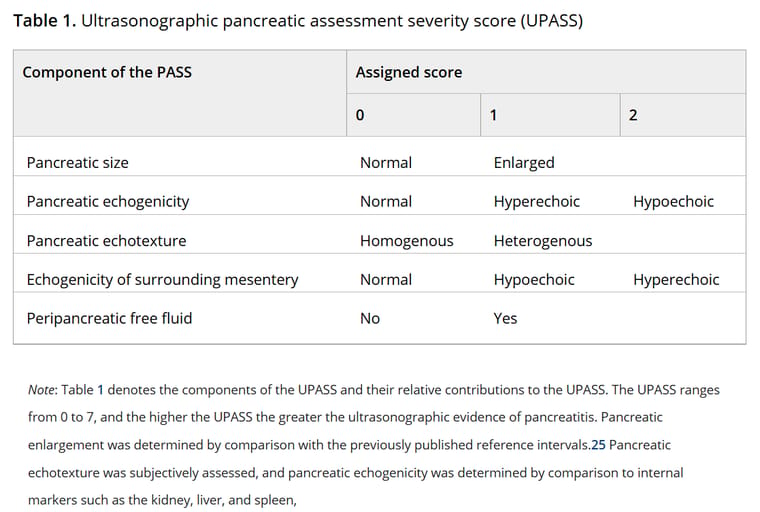- Veterinary View Box
- Posts
- US is not great for pancreatitis.....
US is not great for pancreatitis.....
Journal of Veterinary Internal Medicine (JVIM) 2020
Harry Cridge, Alyssa M. Sullivant, Robert W. Wills, Alison M. Lee
Background
Canine pancreatitis is commonly diagnosed using clinical signs, abdominal ultrasound (AUS), and the specific canine pancreatic lipase (Spec cPL) assay. However, veterinarians frequently rely on AUS findings to diagnose pancreatitis and assess disease severity, despite limited validation. This study aimed to determine:
-The correlation between AUS severity, Spec cPL, and clinical diagnosis (CDx) of pancreatitis.
-Whether specific AUS abnormalities correlate more strongly with pancreatitis than others.
-If AUS severity mirrors clinical severity indices.
-Whether changes in AUS findings reflect changes in Spec cPL or CDx.
-The sensitivity and specificity of AUS for diagnosing pancreatitis.
Methods
Study Design: Retrospective case-control study.
Study Population:
-157 client-owned dogs with clinical signs of gastrointestinal or pancreatic disease.
-All had AUS and Spec cPL performed within 30 hours of each other.
Ultrasound Evaluation:
-AUS images were retrospectively reviewed by a board-certified radiologist blinded to clinical data.
-Severity was assessed using the Ultrasonographic Pancreatic Assessment Severity Score (UPASS), which graded:
-Pancreatic size (normal/enlarged).
-Pancreatic echogenicity (hypoechoic/hyperechoic).
-Pancreatic echotexture (homogeneous/heterogeneous).
-Mesenteric echogenicity (normal/hypoechoic/hyperechoic).
-Presence of peripancreatic free fluid (yes/no).
Clinical Severity Indices:
-APPLE (Acute Patient Physiologic and Laboratory Evaluation) score.
-CAPS (Canine Acute Pancreatitis Severity) score.
Statistical Analysis:
-Spearman’s rank correlation measured associations between AUS, Spec cPL, and CDx.
-Sensitivity and specificity of AUS criteria for diagnosing pancreatitis were calculated.
Results
Correlation Between AUS, Spec cPL, and CDx:
-Weak correlation between AUS severity and Spec cPL (rs = 0.0178, P = 0.03).
-Moderate correlation between AUS and CDx (rs = 0.379, P < 0.001).
Most Correlated AUS Features:
-Pancreatic echogenicity (rs = 0.365, P < 0.001).
-Mesenteric echogenicity (rs = 0.343, P < 0.001).
-Pancreatic size (rs = 0.285, P < 0.001).
Correlation Between AUS and Clinical Severity Indices:
-No significant correlation between AUS severity and APPLE (P = 0.11) or CAPS (P = 0.21) scores.
Change in AUS vs. Change in Spec cPL or CDx:
-No correlation between changes in AUS and changes in Spec cPL or CDx (P > 0.05).
Sensitivity and Specificity of AUS for Pancreatitis:
If any one AUS abnormality (pancreatic enlargement, altered echogenicity) was used for diagnosis:
-Sensitivity: 89% (95% CI: 71.8%–97.7%).
-Specificity: 43% (95% CI: 34.0%–51.6%).
If all three major AUS criteria were required:
-Sensitivity: 43% (95% CI: 24.5%–62.8%).
-Specificity: 92% (95% CI: 85.3%–95.7%).
Limitations
-Retrospective study design, with potential selection bias.
-No histopathologic confirmation of pancreatitis, relying on clinical diagnosis.
-Interobserver variability in ultrasound interpretation not assessed.
-Small sample of dogs with serial imaging, limiting conclusions on disease progression.
Conclusions
AUS should not be used in isolation to diagnose pancreatitis in dogs. While moderately correlated with CDx, AUS findings had only a weak correlation with Spec cPL and did not reflect clinical severity indices. Changes in AUS did not correlate with disease progression, and sensitivity and specificity varied depending on criteria used. A quantitative pancreatic lipase assay (e.g., Spec cPL) should always accompany AUS when assessing dogs for pancreatitis.

How did we do? |
Disclaimer: The summary generated in this email was created by an AI large language model. Therefore errors may occur. Reading the article is the best way to understand the scholarly work. The figure presented here remains the property of the publisher or author and subject to the applicable copyright agreement. It is reproduced here as an educational work. If you have any questions or concerns about the work presented here, reply to this email.